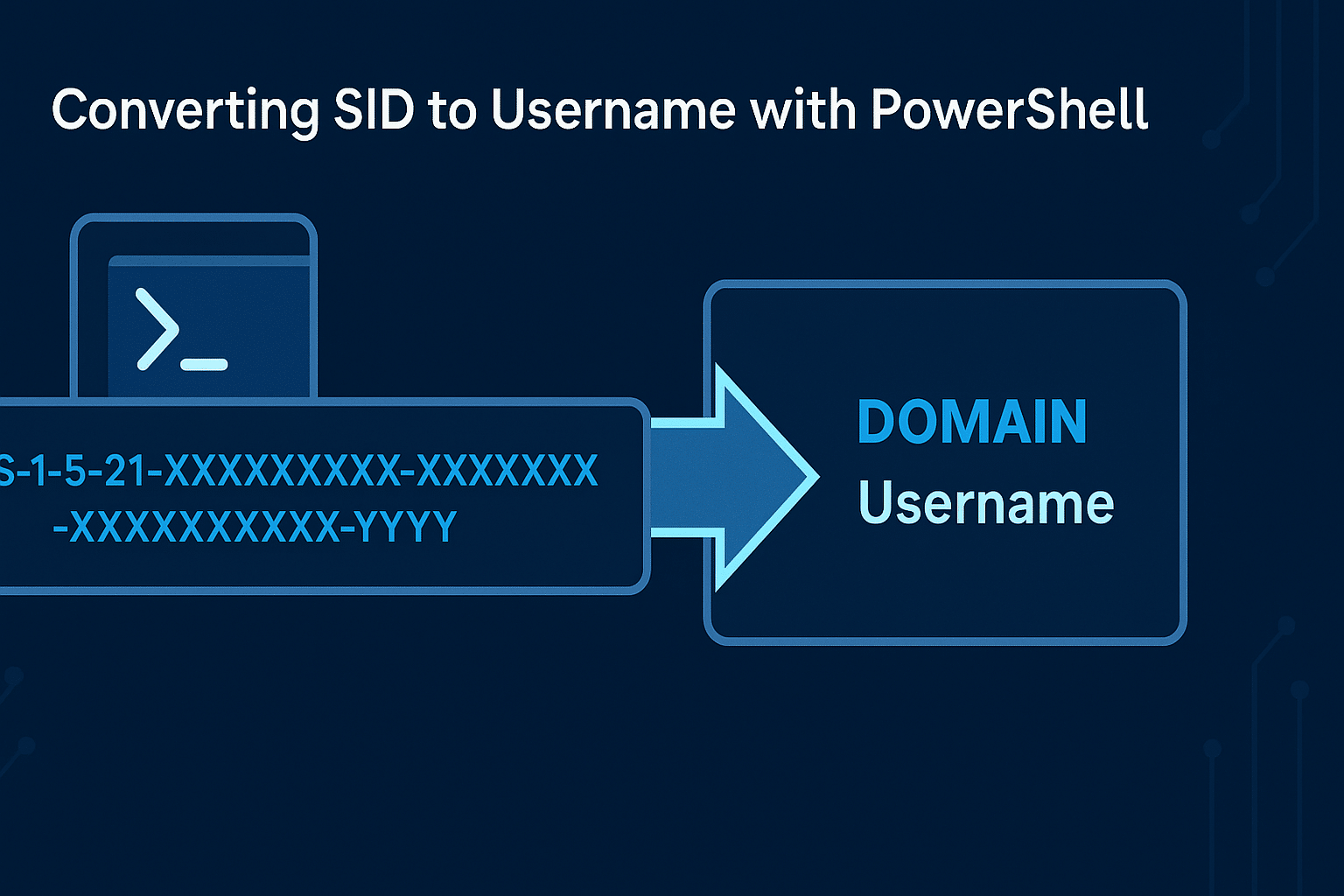Managing Active Directory (AD) efficiently is a critical task for system administrators. Often, there’s a need to synchronize or duplicate attribute values across different AD objects to maintain consistency and streamline operations. Whether you’re updating user profiles, groups, or other AD objects, manually copying attribute values can be time-consuming and error-prone.
In this blog post, we’ll explore a PowerShell script that automates the process of copying one AD attribute to another for specified objects within an Organizational Unit (OU). This script is versatile, allowing you to define source and target attributes, specify object classes, and choose whether to process sub-OUs recursively.
Table of Contents
Prerequisites
Before diving into the script, ensure you have the following:
- Active Directory Module for PowerShell:
- The script relies on the Active Directory module. Install it via Remote Server Administration Tools (RSAT) if not already available.
- Installation Command (Windows 10/11):
Add-WindowsCapability -Online -Name "Rsat.ActiveDirectory.DS-LDS.Tools~~~~0.0.1.0"
- Appropriate Permissions:
- Ensure the account running the script has sufficient privileges to read and modify AD objects within the target OU.
- PowerShell Version:
- The script is compatible with PowerShell 5.1 and later versions.
The Need for Automation
Imagine needing to update an attribute like extensionAttribute1 across hundreds of user and group objects. Manually editing each object is impractical. Automation not only saves time but also ensures accuracy and consistency across your directory.
Understanding the Script
Let’s break down the key components of the Copy-ADAttribute.ps1 script:
- Parameters:
- SearchBase: The Distinguished Name (DN) of the OU containing the target objects.
- SourceAttribute: The AD attribute from which the value will be copied.
- TargetAttribute: The AD attribute to which the value will be copied.
- ObjectClasses: The types of AD objects to target (e.g.,
user,group). Defaults to both if not specified. - Recursive: A switch to determine whether to process sub-OUs.
- LogFile: Path to the log file for recording actions and errors.
- Module Import and Validation:
- Ensures the Active Directory module is loaded. If not, it attempts to import it.
- Logging Mechanism:
- All actions and errors are logged to a specified file, aiding in auditing and troubleshooting.
- Filter Construction:
- Builds a dynamic filter based on the specified object classes using PowerShell’s filter syntax.
- Attribute Processing:
- Iterates through each retrieved object.
- Copies the value from the source attribute to the target attribute.
- Includes error handling to catch and log any issues during the update process.
- Execution Flow:
- Logs the start and completion of the operation.
- Skips objects where the source attribute is empty or not set.
The script
Copy-ADAttribute.ps1
<#
.SYNOPSIS
Copies the value from a source attribute to a target attribute for specified AD objects within a given OU.
.DESCRIPTION
This script allows administrators to copy the value from one Active Directory attribute to another for users, groups, or any other specified AD object types within a designated Organizational Unit (OU).
It supports recursive processing of sub-OUs and includes robust error handling and logging mechanisms.
.PARAMETER SearchBase
The Distinguished Name (DN) of the Organizational Unit where the objects are located.
.PARAMETER SourceAttribute
The name of the source attribute whose value will be copied.
.PARAMETER TargetAttribute
The name of the target attribute where the value will be copied to.
.PARAMETER ObjectClasses
An array of AD object classes to target (e.g., "user", "group"). Defaults to "user" and "group" if not specified.
.PARAMETER Recursive
A switch parameter to indicate whether sub-OUs should be processed recursively.
.PARAMETER LogFile
The path to the log file where actions and errors will be recorded. Defaults to "C:\Logs\CopyADAttribute.log".
.EXAMPLE
.\Copy-ADAttribute.ps1 -SearchBase "OU=Sales,DC=example,DC=com" -SourceAttribute "extensionAttribute1" -TargetAttribute "extensionAttribute10" -Recursive
Copies the value from `extensionAttribute1` to `extensionAttribute10` for all users and groups in the Sales OU and its sub-OUs.
.NOTES
Ensure that the Active Directory module for Windows PowerShell is installed and imported.
Run the script with sufficient privileges to read and modify AD objects.
#>
param (
[Parameter(Mandatory = $true, HelpMessage = "Provide the Distinguished Name (DN) of the OU.")]
[string]$SearchBase,
[Parameter(Mandatory = $true, HelpMessage = "Name of the source attribute to copy from.")]
[string]$SourceAttribute,
[Parameter(Mandatory = $true, HelpMessage = "Name of the target attribute to copy to.")]
[string]$TargetAttribute,
[Parameter(Mandatory = $false, HelpMessage = "AD object classes to target (e.g., 'user', 'group').")]
[string[]]$ObjectClasses = @("user", "group"),
[Parameter(Mandatory = $false, HelpMessage = "Process sub-OUs recursively.")]
[switch]$Recursive,
[Parameter(Mandatory = $false, HelpMessage = "Path to the log file.")]
[string]$LogFile = "C:\Logs\CopyADAttribute.log"
)
# Ensure the ActiveDirectory module is loaded
if (-not (Get-Module -Name ActiveDirectory)) {
try {
Import-Module ActiveDirectory -ErrorAction Stop
}
catch {
Write-Error "The ActiveDirectory module could not be loaded. Ensure that the RSAT tools are installed."
exit 1
}
}
# Create log directory if it doesn't exist
$logDir = Split-Path -Path $LogFile
if (-not (Test-Path -Path $logDir)) {
try {
New-Item -Path $logDir -ItemType Directory -Force | Out-Null
}
catch {
Write-Error "Failed to create log directory at '$logDir'. $_"
exit 1
}
}
# Function to write log entries
function Write-Log {
param (
[string]$Message,
[string]$Type = "INFO"
)
$timestamp = Get-Date -Format "yyyy-MM-dd HH:mm:ss"
"$timestamp [$Type] - $Message" | Out-File -FilePath $LogFile -Append -Encoding UTF8
}
# Determine the search scope based on the -Recursive parameter
$searchScope = if ($Recursive) { "Subtree" } else { "OneLevel" }
# Build the filter based on object classes
$filter = if ($ObjectClasses.Count -eq 1) {
"objectClass -eq `"$($ObjectClasses[0])`""
}
else {
$filterParts = $ObjectClasses | ForEach-Object { "objectClass -eq `"$($_)`"" }
($filterParts -join " -or ")
}
# Define the properties to retrieve
$properties = @($SourceAttribute, $TargetAttribute)
# Log the start of the operation
Write-Log "Starting attribute copy: '$SourceAttribute' -> '$TargetAttribute' in OU '$SearchBase' with scope '$searchScope'. Target object classes: $($ObjectClasses -join ', ')."
try {
# Retrieve the targeted AD objects
$objects = Get-ADObject -Filter $filter -SearchBase $SearchBase -SearchScope $searchScope -Properties $properties
}
catch {
Write-Log "Error retrieving objects from the OU: $_" "ERROR"
exit 1
}
if ($objects.Count -eq 0) {
Write-Log "No objects found matching the criteria." "WARN"
exit 0
}
foreach ($obj in $objects) {
$objectName = $obj.Name
$objectClass = $obj.objectClass
# Retrieve the source attribute value
$sourceValue = $obj.$SourceAttribute
if ($null -ne $sourceValue -and $sourceValue -ne "") {
# Prepare the modification
$mod = @{ $TargetAttribute = $sourceValue }
try {
# Update the target attribute
Set-ADObject -Identity $obj -Replace $mod -ErrorAction Stop
Write-Log "Successfully updated '$objectClass' object '$objectName': Set '$TargetAttribute' to '$sourceValue'."
}
catch {
Write-Log "Failed to update '$objectClass' object '$objectName': $_" "ERROR"
}
}
else {
Write-Log "Skipped '$objectClass' object '$objectName': '$SourceAttribute' is empty or not set." "WARN"
}
}
# Log the completion of the operation
Write-Log "Attribute copy operation completed."
Script Walkthrough
1. Setting Up Parameters
The script begins by defining parameters, allowing flexibility in specifying different attributes and object types.
param (
[Parameter(Mandatory = $true, HelpMessage = "Provide the Distinguished Name (DN) of the OU.")]
[string]$SearchBase,
[Parameter(Mandatory = $true, HelpMessage = "Name of the source attribute to copy from.")]
[string]$SourceAttribute,
[Parameter(Mandatory = $true, HelpMessage = "Name of the target attribute to copy to.")]
[string]$TargetAttribute,
[Parameter(Mandatory = $false, HelpMessage = "AD object classes to target (e.g., 'user', 'group').")]
[string[]]$ObjectClasses = @("user", "group"),
[Parameter(Mandatory = $false, HelpMessage = "Process sub-OUs recursively.")]
[switch]$Recursive,
[Parameter(Mandatory = $false, HelpMessage = "Path to the log file.")]
[string]$LogFile = "C:\Logs\CopyADAttribute.log"
)
2. Loading the Active Directory Module
The script checks if the Active Directory module is loaded and imports it if necessary.
if (-not (Get-Module -Name ActiveDirectory)) {
try {
Import-Module ActiveDirectory -ErrorAction Stop
}
catch {
Write-Error "The ActiveDirectory module could not be loaded. Ensure that the RSAT tools are installed."
exit 1
}
}
3. Setting Up Logging
A logging mechanism ensures that all actions and errors are recorded for future reference.
# Create log directory if it doesn't exist
$logDir = Split-Path -Path $LogFile
if (-not (Test-Path -Path $logDir)) {
try {
New-Item -Path $logDir -ItemType Directory -Force | Out-Null
}
catch {
Write-Error "Failed to create log directory at '$logDir'. $_"
exit 1
}
}
# Function to write log entries
function Write-Log {
param (
[string]$Message,
[string]$Type = "INFO"
)
$timestamp = Get-Date -Format "yyyy-MM-dd HH:mm:ss"
"$timestamp [$Type] - $Message" | Out-File -FilePath $LogFile -Append -Encoding UTF8
}
4. Defining Search Scope and Filter
Based on the -Recursive parameter, the script sets the search scope and constructs a dynamic filter.
# Determine the search scope based on the -Recursive parameter
$searchScope = if ($Recursive) { "Subtree" } else { "OneLevel" }
# Build the filter based on object classes
$filter = if ($ObjectClasses.Count -eq 1) {
"objectClass -eq `"$($ObjectClasses[0])`""
}
else {
$filterParts = $ObjectClasses | ForEach-Object { "objectClass -eq `"$($_)`"" }
($filterParts -join " -or ")
}
5. Retrieving and Processing Objects
The script fetches the targeted AD objects and updates the target attribute accordingly.
# Define the properties to retrieve
$properties = @($SourceAttribute, $TargetAttribute)
# Log the start of the operation
Write-Log "Starting attribute copy: '$SourceAttribute' -> '$TargetAttribute' in OU '$SearchBase' with scope '$searchScope'. Target object classes: $($ObjectClasses -join ', ')."
try {
# Retrieve the targeted AD objects
$objects = Get-ADObject -Filter $filter -SearchBase $SearchBase -SearchScope $searchScope -Properties $properties
}
catch {
Write-Log "Error retrieving objects from the OU: $_" "ERROR"
exit 1
}
if ($objects.Count -eq 0) {
Write-Log "No objects found matching the criteria." "WARN"
exit 0
}
foreach ($obj in $objects) {
$objectName = $obj.Name
$objectClass = $obj.objectClass
# Retrieve the source attribute value
$sourceValue = $obj.$SourceAttribute
if ($null -ne $sourceValue -and $sourceValue -ne "") {
# Prepare the modification
$mod = @{ $TargetAttribute = $sourceValue }
try {
# Update the target attribute
Set-ADObject -Identity $obj -Replace $mod -ErrorAction Stop
Write-Log "Successfully updated '$objectClass' object '$objectName': Set '$TargetAttribute' to '$sourceValue'."
}
catch {
Write-Log "Failed to update '$objectClass' object '$objectName': $_" "ERROR"
}
}
else {
Write-Log "Skipped '$objectClass' object '$objectName': '$SourceAttribute' is empty or not set." "WARN"
}
}
# Log the completion of the operation
Write-Log "Attribute copy operation completed."
Using the Script
1. Saving the Script
Save the above script as Copy-ADAttribute.ps1 in a secure directory, for example, C:\Scripts\.
2. Creating the Log Directory
Ensure that the log directory exists or allow the script to create it. By default, the script logs to C:\Logs\CopyADAttribute.log. You can modify the -LogFile parameter as needed.
3. Running the Script
Open PowerShell with administrative privileges and execute the script with the required parameters. Below are examples demonstrating different usage scenarios.
Example 1: Basic Attribute Copy
Copy extensionAttribute1 to extensionAttribute10 for all users and groups in a specific OU without processing sub-OUs.
.\Copy-ADAttribute.ps1 `
-SearchBase "OU=Sales,DC=example,DC=com" `
-SourceAttribute "extensionAttribute1" `
-TargetAttribute "extensionAttribute10"
Example 2: Recursive Attribute Copy
Copy department to company for all users within the Sales OU and its sub-OUs.
.\Copy-ADAttribute.ps1 `
-SearchBase "OU=Sales,DC=example,DC=com" `
-SourceAttribute "department" `
-TargetAttribute "company" `
-ObjectClasses "user" `
-Recursive
Example 3: Targeting Specific Object Classes
Copy manager to extensionAttribute5 for only groups within a specified OU.
.\Copy-ADAttribute.ps1 `
-SearchBase "OU=Groups,DC=example,DC=com" `
-SourceAttribute "manager" `
-TargetAttribute "extensionAttribute5" `
-ObjectClasses "group"
Best Practices and Considerations
- Backup Before Changes:
- Always ensure you have a recent backup of your Active Directory or the affected OU before performing bulk modifications.
- Test in a Controlled Environment:
- Before running the script in production, test it in a development or staging environment to verify its behavior.
- Logging and Auditing:
- Utilize the logging feature to maintain records of changes. This is crucial for auditing and troubleshooting.
- Permissions:
- Limit script execution to authorized personnel to prevent unintended or malicious modifications.
- Attribute Validation:
- Ensure that the source attribute contains valid and expected data to prevent data inconsistencies.
- Handling Large Environments:
- For environments with a vast number of objects, consider implementing throttling or batching mechanisms to optimize performance and reduce load.
- Error Handling:
- The script includes basic error handling. Depending on your environment’s complexity, you might need to enhance it to handle specific scenarios or exceptions.



